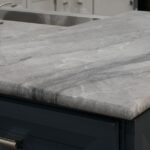So you’re browsing the web for the best quartzite countertops out there. Fortunately for you, a kitchen or bathroom renovation with quartzite slabs comes at a cost-beneficial price, given how long this investment lasts if taken care of properly. In this article, check out some of the major, most popular options on the market today, and be inspired for your next project.
Don’t miss: All About Seams in Quartzite Countertops
What makes for a good quartzite countertop?
Quartzite countertops – which go hand in hand with marble and granite countertops – are made from a metamorphic rock called quartzite, which is used for many interior design applications across the world. Quartzite is formed when sandstone undergoes a process of heat and pressure deep within the Earth’s crust, causing it to recrystallize and become much harder and more durable than its parent rock, sandstone.
Several factors contribute to a high-quality quartzite countertop:
- Quartzite is valued for its durability and resistance to scratches, heat, and etching. A good countertop should withstand daily use without easily showing wear and tear.
- While quartzite is generally less porous than other natural stones like marble, it’s essential to seal it properly to enhance its stain resistance. A good sealant prevents liquids from penetrating the surface and causing stains.
- Choose a quartzite slab that complements your overall design aesthetic. Quartzite comes in various colors, patterns, and veining – so select one that aligns with your style preferences and the design of your space.
- The thickness of the slab can impact its durability and appearance, given how a thicker countertop might be more durable, yet heavier. The finish, whether polished, honed, or leathered, affects both the appearance and maintenance of the countertop.
- Inspect the slab for any flaws, such as fissures, cracks, or inconsistencies in color and texture. Opt for a high-quality slab without structural weaknesses.
- A skilled and experienced installer is crucial for ensuring proper fitting, seam blending (if multiple slabs are used), and sealing of the countertop. This helps prevent issues and ensures the longevity of the countertop.
By considering these factors and selecting a reputable supplier, inspecting the slab, and ensuring proper installation and maintenance (more on that in a bit), you can get a high-quality quartzite countertop that meets both your functional and aesthetic needs!
Some of the best quartzite countertops
When choosing quartzite countertops, consider factors like color, veining patterns, durability, and how well it suits your overall design aesthetic and lifestyle. Additionally, ensure that the specific slab you select is well-sealed to prevent staining and maintain its beauty over time.
Fantasy Brown Quartzite

Known for its unique blend of brown, gray, and white colors with veining that resembles marble. It’s durable and suitable for various design styles.
Taj Mahal Quartzite
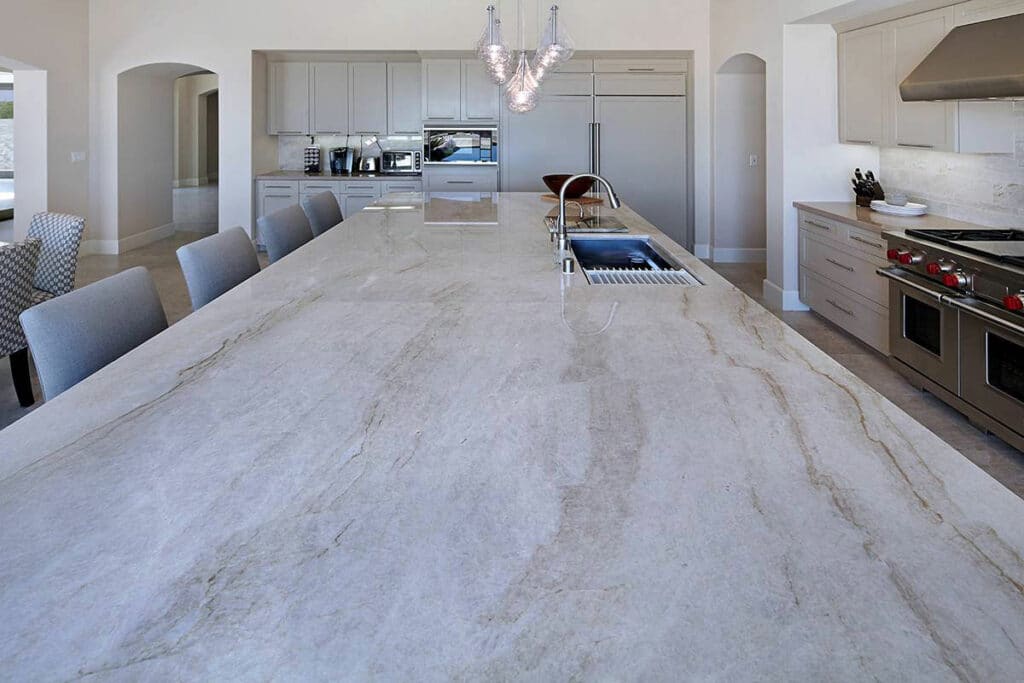
Appreciated for its creamy, light tones and subtle veining, resembling marble but with the durability of quartzite.
Super White Quartzite
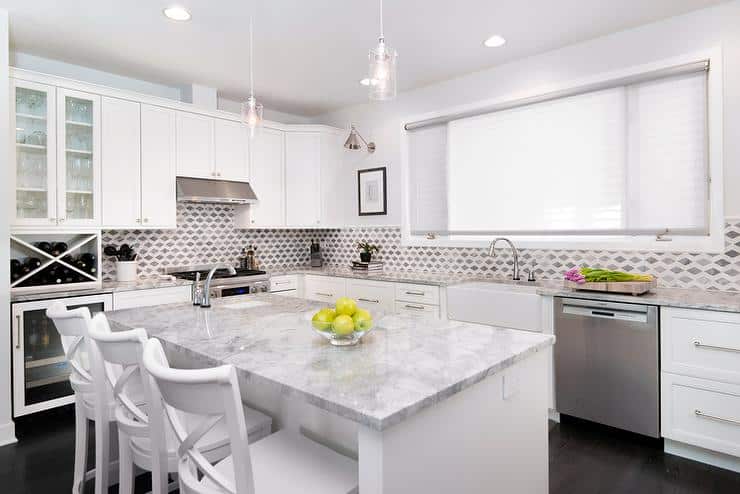
Despite its name, Super White is more of a creamy white or light gray stone with darker veins. It’s admired for its elegant appearance and durability.
White Macaubas Quartzite
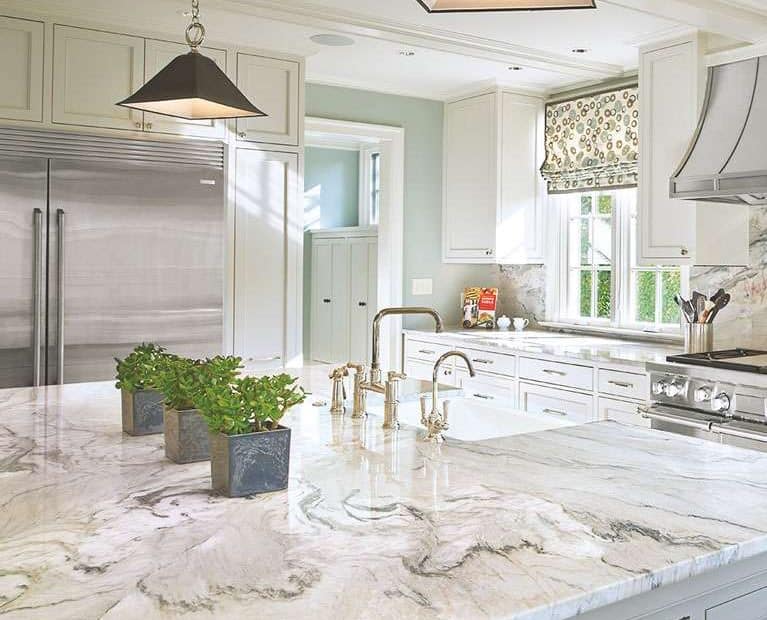
Featuring a white or light gray background with gray or gold veining, this quartzite is often chosen for its bright and elegant look.
Mont Blanc Quartzite
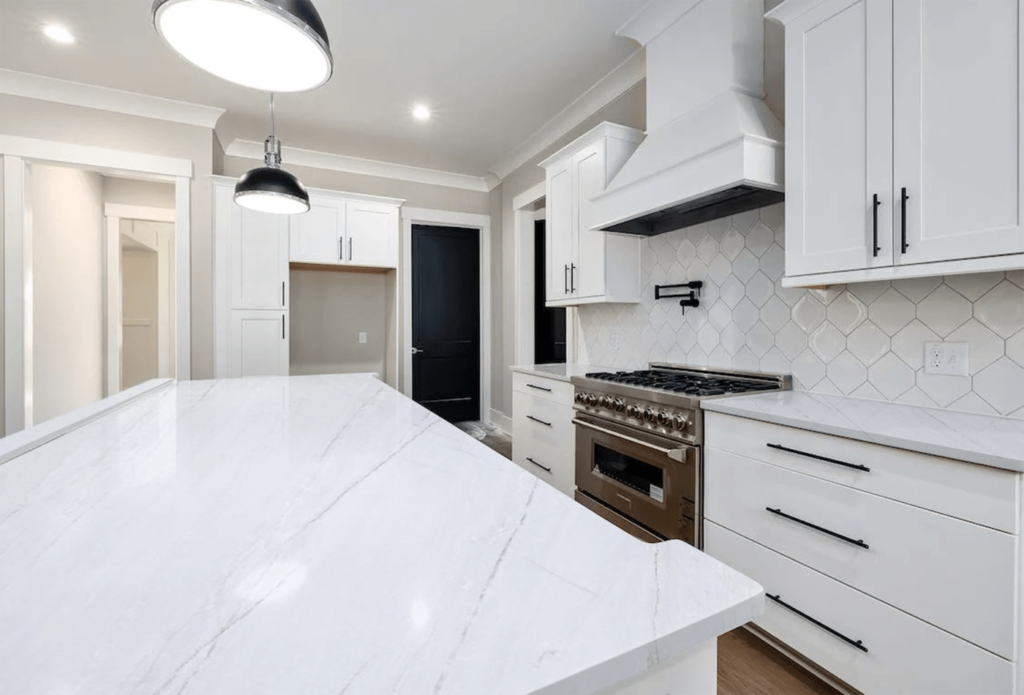
Characterized by its white or light gray background with subtle veining, Mont Blanc is a popular choice for those seeking a softer, lighter color palette.
How to care for your quartzite slabs
Preserving the lifespan of your quartzite countertop involves several practices that can be integrated into your daily routine.
Firstly, if we’re talking kitchens, it’s crucial to use cutting boards or mats when preparing food. Avoid cutting directly on the quartzite surface to prevent scratches and maintain the countertop’s finish. Additionally, utilize trivets or hot pads under hot pots, pans, or heated items. While quartzite is heat-resistant, using these items can prevent any potential thermal shock or discoloration that might occur over time.
Promptly cleaning spills is essential, too. Even though quartzite is less porous than granite or marble, acidic substances such as citrus juices, wine, or vinegar can still cause discoloration if left on the surface for extended periods. Wipe up spills with a microfiber cloth immediately to prevent staining.
When cleaning the countertop, opt for mild soap or a pH-balanced cleaner – always avoid abrasive cleaners or harsh chemicals that could damage the surface or strip away the sealant. Regular cleaning helps remove crumbs, dirt, or debris, preventing scratching from abrasive particles and keeping the surface looking clean.
Likewise, you should protect the quartzite from abrasive materials and sharp objects that could scratch or damage the surface. Avoid dragging or placing abrasive items directly on the countertop and use coasters under glasses and cups to prevent water rings and potential etching from acidic beverages.
Lastly, as we mentioned earlier, keep an eye on your sealant of choice; if water stops beading on the surface, it might be time to reapply it. Follow the manufacturer’s recommendations for resealing intervals to ensure the countertop remains well-protected.
By incorporating these practices into your daily activities, you can help maintain the quality, appearance, and longevity of your quartzite countertop, ensuring it remains both beautiful and functional for years to come.
Find the best quartzite countertops at Eagle Stones!
Based in Sarasota, Florida, we offer the best experts in town for any natural-stone-related business, including supply, installation, and maintenance. If you want to check out our full catalog of quartzite stones, which offers you a wide array of colors, don’t hesitate to contact us today.

We’ll go to your house and even give you a free estimate! What are you waiting for?

